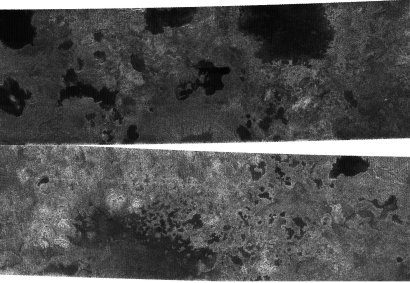Search for Lakes on Titan
25 July 2006
Results from two recent flybys of Titan, by the Cassini spacecraft, have added to the evidence suggesting that hydrocarbon lakes exist on its surface.The first flyby, made in April, focused on the Xanadu feature near the moon's equator. The radar image, resulting in a strip more than 4500 kilometres long, shows Xanadu is surrounded by darker terrain, reminiscent of a free-standing landmass. At the region's western edge, dark sand dunes appear to give way to land cut by river networks, hills and valleys. These narrow river networks flow onto darker areas, which may be lakes.
 |
|
RADAR image over the continent-sized Xanadu region, one of the brightest regions on Titan. |
The second set of observations was made on the night of 21/22 July 2006 when Cassini passed less than 1000 km above the surface. The orientation of this flyby enabled the first observations of Titan's north polar region, which is currently in perpetual winter darkness.
Observations made by the Cassini Radar (RADAR) during the flyby reveal strong evidence for the existence of hydrocarbon lakes on Titan in the form of dark patches scattered over the high latitude region.
Some of the dark patches appear to have channels leading in or out of them, with shapes that strongly imply they were carved by liquid. Some of the dark patches and connecting channels are completely black, meaning that they reflect back essentially no radar signal, and must therefore be extremely smooth.
In some cases rims can be seen around the dark patches, suggesting deposits that might form as liquid evaporates. The abundant methane in Titan's atmosphere is stable as a liquid under Titan conditions, as well as its abundant chemical product, ethane, but liquid water is not.
For these reasons, scientists interpret the observed dark areas as lakes of liquid methane or ethane, which would make Titan the only body in the solar system besides Earth known to possess lakes.
These results tie in with the findings of the Huygens probe: there is a high probability that methane or ethane exist in solid or liquid form on the surface. Possible lakes near the poles, could act as a reservoir and be subject to seasonal variations in size. Further observations during the remainder of the Cassini mission could reveal such differences.

